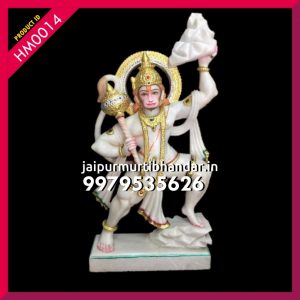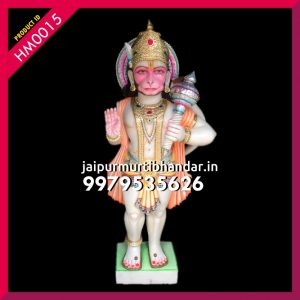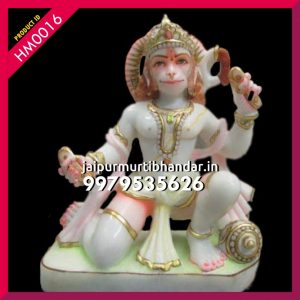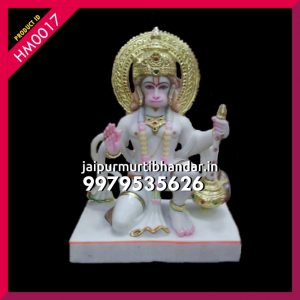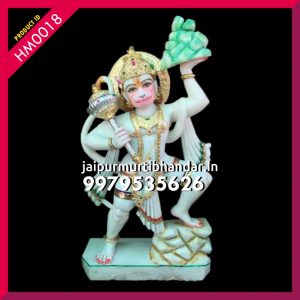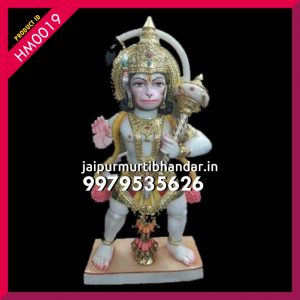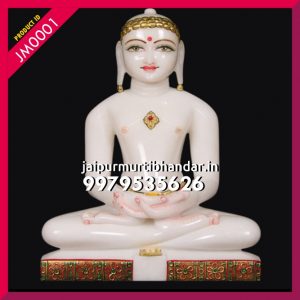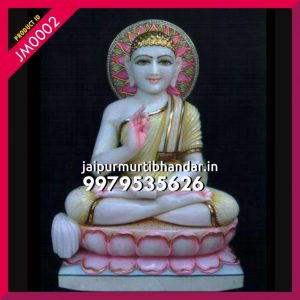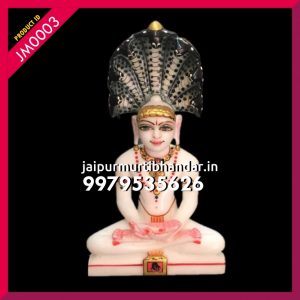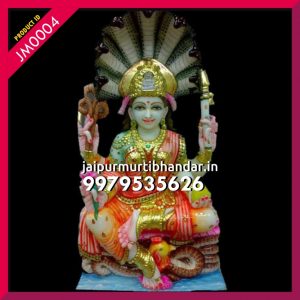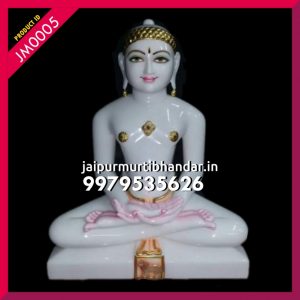-
Hanuman Ji -HM0015
Hanuman is one of the most popular gods of Hindus. He is also known by other names like Hanumat. His mother?s name was Anjana. Based on her mother?s name, Hanuman is sometimes called Anjaneya, that is, one born of Anjana. His father?s name was Vayu. According to Hindu mythology, Vayu is the god of winds. Hanuman?s image shows him as a strong man with the face of a monkey. He also has a tail. Hanuman was awarded boon of Immortality by Mother Sita ( Wife of Lord rama) and is still alive
Hanuman is a very powerful and strong god. He finds an important place in the Ramayana. He was a devotee of Rama, a form (avatar) of Vishnu, a god of Hindus. Hanuman is a figure of strength, perseverance and devotion. When he was young he thought the sun a mango.
-
Hanuman Ji -HM0016
Hanuman is one of the most popular gods of Hindus. He is also known by other names like Hanumat. His mother?s name was Anjana. Based on her mother?s name, Hanuman is sometimes called Anjaneya, that is, one born of Anjana. His father?s name was Vayu. According to Hindu mythology, Vayu is the god of winds. Hanuman?s image shows him as a strong man with the face of a monkey. He also has a tail. Hanuman was awarded boon of Immortality by Mother Sita ( Wife of Lord rama) and is still alive
Hanuman is a very powerful and strong god. He finds an important place in the Ramayana. He was a devotee of Rama, a form (avatar) of Vishnu, a god of Hindus. Hanuman is a figure of strength, perseverance and devotion. When he was young he thought the sun a mango.
-
Hanuman Ji -HM0017
Hanuman is one of the most popular gods of Hindus. He is also known by other names like Hanumat. His mother?s name was Anjana. Based on her mother?s name, Hanuman is sometimes called Anjaneya, that is, one born of Anjana. His father?s name was Vayu. According to Hindu mythology, Vayu is the god of winds. Hanuman?s image shows him as a strong man with the face of a monkey. He also has a tail. Hanuman was awarded boon of Immortality by Mother Sita ( Wife of Lord rama) and is still alive
Hanuman is a very powerful and strong god. He finds an important place in the Ramayana. He was a devotee of Rama, a form (avatar) of Vishnu, a god of Hindus. Hanuman is a figure of strength, perseverance and devotion. When he was young he thought the sun a mango.
-
Hanuman Ji -HM0018
Hanuman is one of the most popular gods of Hindus. He is also known by other names like Hanumat. His mother?s name was Anjana. Based on her mother?s name, Hanuman is sometimes called Anjaneya, that is, one born of Anjana. His father?s name was Vayu. According to Hindu mythology, Vayu is the god of winds. Hanuman?s image shows him as a strong man with the face of a monkey. He also has a tail. Hanuman was awarded boon of Immortality by Mother Sita ( Wife of Lord rama) and is still alive
Hanuman is a very powerful and strong god. He finds an important place in the Ramayana. He was a devotee of Rama, a form (avatar) of Vishnu, a god of Hindus. Hanuman is a figure of strength, perseverance and devotion. When he was young he thought the sun a mango.
-
Hanuman Ji -HM0019
Hanuman is one of the most popular gods of Hindus. He is also known by other names like Hanumat. His mother?s name was Anjana. Based on her mother?s name, Hanuman is sometimes called Anjaneya, that is, one born of Anjana. His father?s name was Vayu. According to Hindu mythology, Vayu is the god of winds. Hanuman?s image shows him as a strong man with the face of a monkey. He also has a tail. Hanuman was awarded boon of Immortality by Mother Sita ( Wife of Lord rama) and is still alive
Hanuman is a very powerful and strong god. He finds an important place in the Ramayana. He was a devotee of Rama, a form (avatar) of Vishnu, a god of Hindus. Hanuman is a figure of strength, perseverance and devotion. When he was young he thought the sun a mango.
-
Hanuman Ji -HM0020
Hanuman is one of the most popular gods of Hindus. He is also known by other names like Hanumat. His mother?s name was Anjana. Based on her mother?s name, Hanuman is sometimes called Anjaneya, that is, one born of Anjana. His father?s name was Vayu. According to Hindu mythology, Vayu is the god of winds. Hanuman?s image shows him as a strong man with the face of a monkey. He also has a tail. Hanuman was awarded boon of Immortality by Mother Sita ( Wife of Lord rama) and is still alive
Hanuman is a very powerful and strong god. He finds an important place in the Ramayana. He was a devotee of Rama, a form (avatar) of Vishnu, a god of Hindus. Hanuman is a figure of strength, perseverance and devotion. When he was young he thought the sun a mango.
-
Jain Murtii -JM0001
Lord Mahavira was the twenty-fourth and last Jain Tirthankara according to the Jain philosophy. A Tirthankara is an enlightened soul who is born as a human being and attains perfection through intense meditation. For a Jain, Lord Mahavira is no less than God and his philosophy is like the Bible. Born as Vardhamana Mahavir, he later came to be known as Bhagvan Mahaveer. At the age of 30, Vardhamana left his home in pursuit of spiritual awakening, and for the next twelve-and-a-half years, he practiced severe meditation and penance, after which he became omniscient. After achieving Kevala Jnana, he travelled throughout the Indian subcontinent to teach Jain philosophy for the next 30 years.
-
Jain Murtii -JM0002
Lord Mahavira was the twenty-fourth and last Jain Tirthankara according to the Jain philosophy. A Tirthankara is an enlightened soul who is born as a human being and attains perfection through intense meditation. For a Jain, Lord Mahavira is no less than God and his philosophy is like the Bible. Born as Vardhamana Mahavir, he later came to be known as Bhagvan Mahaveer. At the age of 30, Vardhamana left his home in pursuit of spiritual awakening, and for the next twelve-and-a-half years, he practiced severe meditation and penance, after which he became omniscient. After achieving Kevala Jnana, he travelled throughout the Indian subcontinent to teach Jain philosophy for the next 30 years.
-
Jain Murtii -JM0003
Lord Mahavira was the twenty-fourth and last Jain Tirthankara according to the Jain philosophy. A Tirthankara is an enlightened soul who is born as a human being and attains perfection through intense meditation. For a Jain, Lord Mahavira is no less than God and his philosophy is like the Bible. Born as Vardhamana Mahavir, he later came to be known as Bhagvan Mahaveer. At the age of 30, Vardhamana left his home in pursuit of spiritual awakening, and for the next twelve-and-a-half years, he practiced severe meditation and penance, after which he became omniscient. After achieving Kevala Jnana, he travelled throughout the Indian subcontinent to teach Jain philosophy for the next 30 years.
-
Jain Murtii -JM0004
Lord Mahavira was the twenty-fourth and last Jain Tirthankara according to the Jain philosophy. A Tirthankara is an enlightened soul who is born as a human being and attains perfection through intense meditation. For a Jain, Lord Mahavira is no less than God and his philosophy is like the Bible. Born as Vardhamana Mahavir, he later came to be known as Bhagvan Mahaveer. At the age of 30, Vardhamana left his home in pursuit of spiritual awakening, and for the next twelve-and-a-half years, he practiced severe meditation and penance, after which he became omniscient. After achieving Kevala Jnana, he travelled throughout the Indian subcontinent to teach Jain philosophy for the next 30 years.
-
Krishna -KR0001
Lord Mahavira was the twenty-fourth and last Jain Tirthankara according to the Jain philosophy. A Tirthankara is an enlightened soul who is born as a human being and attains perfection through intense meditation. For a Jain, Lord Mahavira is no less than God and his philosophy is like the Bible. Born as Vardhamana Mahavir, he later came to be known as Bhagvan Mahaveer. At the age of 30, Vardhamana left his home in pursuit of spiritual awakening, and for the next twelve-and-a-half years, he practiced severe meditation and penance, after which he became omniscient. After achieving Kevala Jnana, he travelled throughout the Indian subcontinent to teach Jain philosophy for the next 30 years.
-
Krishna -KR0002
Krishna is represented in the Indian traditions in many ways, but with some common features. His iconography typically depicts him with black, dark, or blue skin, like Vishnu.However, ancient and medieval reliefs and stone-based arts depict him in the natural color of the material out of which he is formed, both in India and in southeast Asia.In some texts, his skin is poetically described as the color of Jambul (Jamun, a purple-colored fruit).
Krishna is often depicted wearing a peacock-feather wreath or crown, and playing the bansuri (Indian flute). In this form, he is usually shown standing with one leg bent in front of the other in the Tribhanga posture. He is sometimes accompanied by cows or a calf, which symbolise the divine herdsman Govinda. Alternatively, he is shown as a romantic and seductive man with the gopis (milkmaids), often making music or playing pranks.
Krishna lifting Govardhana at Bharat Kala Bhavan, recovered from a Muslim graveyard in Varanasi. It is dated to the Gupta Empire era.
In other icons, he is a part of battlefield scenes of the epic Mahabharata. He is shown as a charioteer, notably when he is addressing the Pandava prince Arjuna character, symbolically reflecting the events that led to the Bhagavad Gita ? a scripture of Hinduism. In these popular depictions, Krishna appears in the front as the charioteer, either as a counsel listening to Arjuna, or as the driver of the chariot while Arjuna aims his arrows in the battlefield of Kurukshetra.
God Idols
- Home
- Shop
- Marble Statue
- God Idols

 +91 9979 535 626
+91 9979 535 626